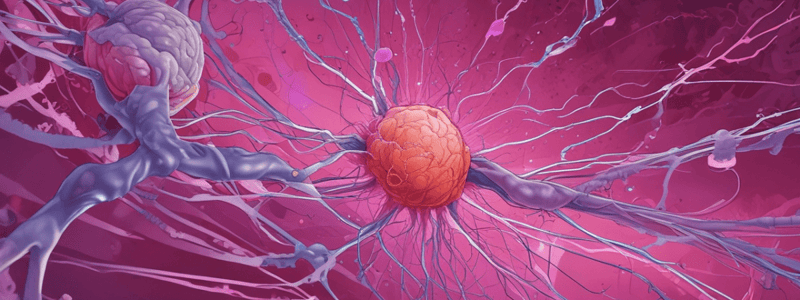Podcast
Questions and Answers
What two types of vessels can cancer cells enter to travel around the body and form metastases?
What two types of vessels can cancer cells enter to travel around the body and form metastases?
blood vessels and lymphatic vessels
What is the process called when cancer cells break through the basement membrane and enter the extracellular matrix?
What is the process called when cancer cells break through the basement membrane and enter the extracellular matrix?
invasion
What type of molecules do cancer cells develop to bind to the basement membrane?
What type of molecules do cancer cells develop to bind to the basement membrane?
cell adhesion molecules
What type of enzymes do cancer cells secrete to degrade the basement membrane?
What type of enzymes do cancer cells secrete to degrade the basement membrane?
What is the process called when cancer cells travel through the bloodstream or lymphatic system to form metastases?
What is the process called when cancer cells travel through the bloodstream or lymphatic system to form metastases?
What is the purpose of the repeated process of binding to matrix products in cancer cell migration?
What is the purpose of the repeated process of binding to matrix products in cancer cell migration?
What is the role of laminin or fibronectin receptors in cancer cell migration?
What is the role of laminin or fibronectin receptors in cancer cell migration?
What is the final step in the process of cancer cell metastasis via lymphatic or blood vessels?
What is the final step in the process of cancer cell metastasis via lymphatic or blood vessels?
What is the process by which cancer cells exit the circulation and arrive at the site where they are going to form a new secondary deposit?
What is the process by which cancer cells exit the circulation and arrive at the site where they are going to form a new secondary deposit?
What is the minimum size required for a tumor to grow and survive as a metastasis?
What is the minimum size required for a tumor to grow and survive as a metastasis?
What molecules do tumor cells secrete to stimulate new vessel growth by angiogenesis?
What molecules do tumor cells secrete to stimulate new vessel growth by angiogenesis?
What is the term for the process by which new blood vessels are formed from pre-existing ones?
What is the term for the process by which new blood vessels are formed from pre-existing ones?
What is the term for the passage of cells through the blood vessel wall and into the surrounding tissue?
What is the term for the passage of cells through the blood vessel wall and into the surrounding tissue?
How do cancer cells avoid detection by the immune system during metastasis?
How do cancer cells avoid detection by the immune system during metastasis?
What is the term for the movement of cancer cells from the primary tumor site to distant organs through the bloodstream or lymphatic system?
What is the term for the movement of cancer cells from the primary tumor site to distant organs through the bloodstream or lymphatic system?
What is the role of endothelial cells in the extravasation of cancer cells?
What is the role of endothelial cells in the extravasation of cancer cells?
What is the primary response to injury that leads to the development of cervical carcinoma in situ?
What is the primary response to injury that leads to the development of cervical carcinoma in situ?
What is the significance of the basement membrane in the development of invasive cervical carcinoma?
What is the significance of the basement membrane in the development of invasive cervical carcinoma?
Describe the changes that occur in the epithelium during dysplasia.
Describe the changes that occur in the epithelium during dysplasia.
What is the difference between metaplasia and dysplasia in terms of reversibility?
What is the difference between metaplasia and dysplasia in terms of reversibility?
What is the definition of metastases in the context of cervical carcinoma?
What is the definition of metastases in the context of cervical carcinoma?
What is the role of the basement membrane in preventing metastases?
What is the role of the basement membrane in preventing metastases?
What is the significance of carcinoma in situ in terms of clinical importance?
What is the significance of carcinoma in situ in terms of clinical importance?
What is the relationship between dysplasia and carcinoma in situ?
What is the relationship between dysplasia and carcinoma in situ?
Flashcards are hidden until you start studying
Study Notes
Cancer Cell Metastasis
- Cancer cells bind to the edge of blood vessels, roll along, and adhere to endothelial cells, then wriggle through the blood vessel wall to exit the circulation and form a new secondary deposit (metastases).
- Cancer cells secrete growth factors (VEGF, FGF, TGFB, and angiogenin) to stimulate new vessel growth by angiogenesis, which is necessary for the tumour to grow.
- A new blood supply is required for the tumour to grow greater than 0.05 mm.
Invasive Carcinoma Development
- The development of invasive carcinoma begins with metastasis, which involves breaking through the basement membrane (BM) and entering the extracellular matrix (ECM).
- Cancer cells bind to the ECM via integrins and develop cell adhesion molecules, then secrete proteolytic enzymes to degrade the BM and ECM.
- Cells repeat the process of binding, degrading, and moving through the ECM until they reach a lymphatic or blood vessel.
Cancer Terminology
- Cancer terminology is important to understand, as the disease becomes life-threatening once cells break through the BM and enter the ECM.
- Ocular tumours are a type of cancer that occurs in the eye.
Stages of Invasive Carcinoma
-
The stages of invasive carcinoma include:
- Breaking through the basement membrane (BM) and entering the extracellular matrix (ECM), allowing the tumor cells to penetrate the underlying connective tissue.
- Invading through the underlying tissues, where the tumor cells migrate and infiltrate the surrounding tissue, disrupting normal tissue architecture.
- Entering a blood vessel or lymphatic vessel, a process known as intravasation, which enables the tumor cells to gain access to the circulatory system and potentially metastasize to distant organs.
- Travelling to another part of the body and setting up a new growth (metastases), where the tumor cells adapt to the new microenvironment and establish a secondary tumor.
These stages are critical in the progression of invasive carcinoma, as they enable the tumor cells to escape local tissue boundaries and establish systemic disease.
Studying That Suits You
Use AI to generate personalized quizzes and flashcards to suit your learning preferences.




